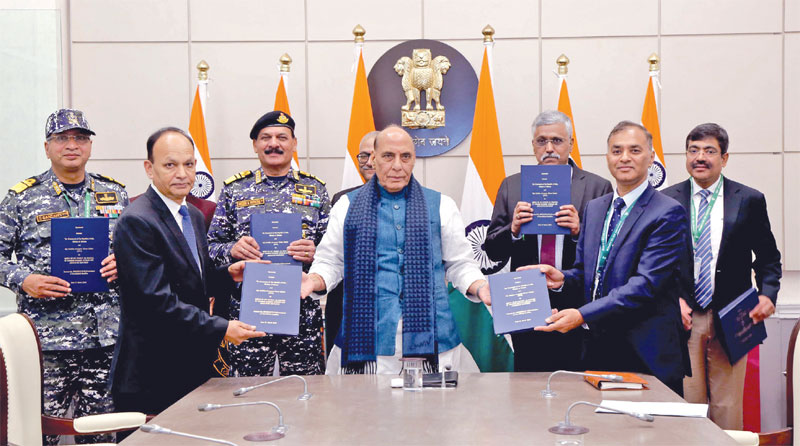The Indian Armed Forces have been meeting critical shortfalls through emergency procurement
Mohammad Asif Khan
Following the incursion of Chinese troops on the Line of Actual Control in Eastern Ladakh in early May 2020, the Emergency Procurement (EP) mechanism outlined in the Defence Procurement Manual of 2021 has allowed the armed forces to address crucial deficiencies in combat readiness.

EP powers were first granted to the armed forces by the ministry of defence following the 2016 Uri terror attack. These powers were introduced to help the armed forces circumvent the slow, bureaucratic system of procurement, allowing them to quickly ink contracts for essential equipment and arms.
Under these EP powers, each branch of the armed forces independently signs contracts valued at up to INR 300 crore, bypassing the lengthy procedures typically involved in acquiring new systems for modernisation by Defence Acquisition Procedure (DAP). The EP provision has been extended to all three branches of the military—army, navy and air force—on four occasions, enabling them to procure various offensive and defensive systems.
The army has utilised the EP mechanism to address significant deficiencies across various areas such as firepower, drone warfare, mobility, communication and soldier personal protection, among others. The EP's main aim was to address critical operational shortcomings, particularly along the northern borders.
The emergency procurement conducted by the armed forces encompassed a range of critical systems such as remote-controlled weapon systems, air defence missiles, anti-tank missiles, satellite downlink and recording systems, tiny aperture terminals (VSAT) and portable mobile terminals.
The army is observing 2024 as the ‘Year of Technology Absorption’ to focus on modernisation and technology integration and is working on several projects to reshape and remodel the functional processes to bring in a quantum jump in its capabilities. For the army, these acquisitions also included multi-terrain vehicles, high-mobility reconnaissance vehicles, loitering munitions and drones, among others.
In the initial three phases, the army utilised around INR 6,500 crores, finalising 68 contracts. More than INR 1,800 crores was allocated for the procurement of modern weapons, equipment and ammunition, along with a similar sum utilised for communication and non-communication gear. Additionally, approximately INR 900 crores was earmarked for 10 contracts related to surveillance equipment, and close to INR 1,500 crores was allotted for 14 projects involving drones and counter-drone systems, around INR 1,000 crores was directed towards enhancing mobility across different terrains and acquiring engineering equipment.
Apart from the army, the Indian Air Force (IAF) entered into 65 contracts valued at over Rs 8,000 crores, while the Indian Navy secured 35 contracts worth Rs 4,500 crores during this period. Unlike the initial three tranches, which involved procurement deals with countries such as Russia, Israel and France, the latest EP-4 exclusively focused on acquisitions from domestic manufacturers.
During EP-IV, spanning from September 2022 to September 2023, over 70 projects totalling nearly Rs 11,000 crores were executed. In addition to the 49 schemes contracted under the fourth round of EP, 34 schemes worth approximately Rs 7,000 crores were procured. Niche technologies like logistic and nano drones, counter-drones, loiter munitions, unarmed aerial vehicles or UAV-launched precision-guided missiles, and automatic spectrum monitoring systems have also been procured.
The primary objective of the EP was to plug critical operational gaps, especially along the northern borders. This analysis dives into the allocated funds and targeted areas to understand the overall impact of the fourth Emergency Procurement Tranche.
Focus on Offensive and Defensive Systems
A portion of the tranche, roughly Rs 130 crore, addresses weapon systems. This allocation strengthens the military's offensive capabilities, enhancing its ability to deter aggression and respond decisively in conflict situations. The specific weaponry procured may include modern firearms, artillery upgrades or next-generation missiles. Equally important is soldier protection. Another Rs 130 crore is dedicated to acquiring advanced body armour, helmets and specialised gear for various terrains and operations. This investment directly translates to increased troop survivability on the battlefield.
Enhanced Intelligence Gathering: Modern warfare places a premium on gathering intelligence, conducting reconnaissance and maintaining constant surveillance. Approximately Rs 150 crore is earmarked for intelligence, reconnaissance and surveillance (ISR) projects. This could encompass advanced radar systems for border monitoring, aerial reconnaissance platforms, sophisticated communication intercepts and electronic warfare equipment. A robust ISR system provides a significant advantage by improving situational awareness, enabling early threat detection and facilitating more effective tactical planning.
Drones: The increasing use of unmanned aerial vehicles (UAVs), or drones, has significantly impacted modern warfare. Recognising this shift, a substantial Rs 200 crore is allocated for drone and counter-drone systems. This could involve acquiring tactical reconnaissance drones for intelligence gathering, armed drones for targeted strikes and advanced counter-drone systems to neutralise hostile drone threats. Mastering drone technology offers tactical flexibility, enhances battlefield dominance and acts as a force multiplier for the armed forces.
You must be logged in to view this content.

